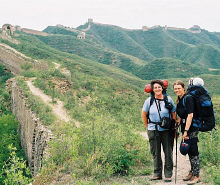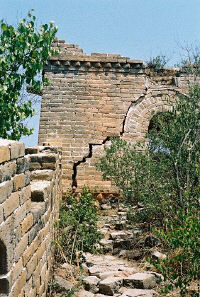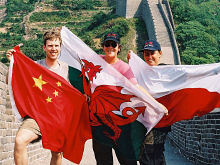Walking the Great Wall of China
China
In China they say you are not a man until you have been to the Great Wall. They say it stretches for 10,000 km (6000 miles) from the desert to the sea and is the one manmade structure you can see from space. So, what is this Great Wall? Where does the truth end and where do the legends begin?

 Intrepid wall walkers, Miranda and Iza, at GubeikhouWhen my friend Miranda announced that she was going to be walking the Great Wall a couple of years ago I was intrigued. How would the reality match up to all the stories we had heard? In the spring and summer of 2002, she and her companion Iza walked much of the Wall and the regular email missives from China were fascinating. Unsupported they moved from village to village, communicating with the help of a phrase book, usually finding a kindly soul to take them in for the night. Some times they couldn’t find the Wall at all; at others it went on for days without a break.
Intrepid wall walkers, Miranda and Iza, at GubeikhouWhen my friend Miranda announced that she was going to be walking the Great Wall a couple of years ago I was intrigued. How would the reality match up to all the stories we had heard? In the spring and summer of 2002, she and her companion Iza walked much of the Wall and the regular email missives from China were fascinating. Unsupported they moved from village to village, communicating with the help of a phrase book, usually finding a kindly soul to take them in for the night. Some times they couldn’t find the Wall at all; at others it went on for days without a break.
But this was not the Wall I had pictured, for the reality was different and much more interesting than the simplistic view I had held. This Wall was built from local raw materials and was never conceived as a single project. Successive emperors and dynasties added to the Wall what they needed; sometimes building over the work of their predecessors; at others building a completely new section many miles away. The Wall we see today is not a single continuous Wall but vastly more complicated and intricate.
For months Miranda and Iza headed east along the deserts between China and Mongolia following a Wall of mud brick with occasional solid towers until as autumn came, the weather closing in and the mountains around Beijing ahead they called it a day for the year but left promising to return. SARS meant that that return was delayed until this April and this time I arranged to head out to China for a couple of weeks to join them for a section of the Wall and see it for myself.
That is how I found myself on a bus heading north out of Beijing towards the town of Yanqing at the end of May. Miranda and Iza had arrived there not without incident as the mountainous terrain was leading to a new set of problems in walking the Wall, compounded by a brief trip to the hospital with an irritated bowel for Miranda the day before I arrived in Beijing.
I arrived with vital supplies – chocolate, tuna fish and lip salve. After a couple of weeks of unseasonably cold weather the temperature was now rising. The problems ahead were explained to me. In the section that lay ahead in Beijing province there is Wall that has been rebuilt for tourists… and then there is the rest of it. Away from the tourist areas, the Wall is only a line of rubble beaten down by the weather and taken over by dense bush and low trees. Paths in this area go from villages in the valleys to their fields and maybe onto the next village. The Wall marches along the ridges and so the chance of path and Wall coinciding are slim. If you happened to be carrying a few machetes and had a large support staff to carry supplies, it would be feasible to hack your way through the undergrowth and follow the Wall. If, however, you don’t, you will be lucky to travel a couple of miles in a day at the end of which you will be stranded on a mountain top with no prospect of food, shelter or water for the night. With the temperatures in the high 30s (high 90s F), this was not a good plan.
My first foray to the Wall was to the popular tourist area of Badaling, thronged with hundreds of Chinese tourists (who tended to go right) and a sprinkling of foreign tourists (who tended to go left). This is the Wall you have seen – well maintained and a straightforward (if arduous) walk up and down the hills. The next day the three of us left Yanqing in quest of some walkable wild Wall. Up into the hills north of Yanqing we drove by taxi and rounding a corner, there she was – a couple of towers visible on the skyline. The road led up through a pass and before we knew it we were heading down the other side with evidence of Wall behind us but not much evidence of it there. Hmm. Back we went again and stopped at the pass and got out to look. Here indeed was the Wall – but here there was only a tumbledown line of rubble of white rock in the trees. This was not going to work. On a couple of peaks in the distance, the ruins of old towers rose up above the forest as unattainable as the moon.
And so to Plan B, bus around the area to places with a good chance of finding walkable Wall (the tourist areas + environs). That was the tale of the rest of the trip – bus journeys blurred into each other; each day offered another section of Wall in a different place. The colour of the Wall changed from grey to red to yellow as the local rocks changed; in places the Wall had been rebuilt and marched proudly along the ridges; in others bushes and trees grew from the centre and in others the pile of rubble only hinted at past glories. Without going into vast details, a few pictures that stand out in my mind from this trip.
Police station at Yanqing. Towards evening with the shadows lengthening. The circles of smoke from Miranda’s and Iza’s cigarettes rise slowly from the laminated wood tables and spiral towards the ceiling, catching the early evening glow. Through no fault of our own we haven’t been properly registered and it is taking the local police an hour and a half to type the information from our passports into the system. The smoke slowly rises as Miranda paces in frustration, the smoke now coming out of her ears. Time stops as we sit in limbo until, passports returned, the pent up energy is released as we surge onto the streets of Yanqing.
Mutianyu. Rebuilt wall with a cable car rising to the peak. Wearily we climb the Wall to its summit and then beyond into less well maintained sections, leaving the razzmatazz of a celebration of US-Chinese friendship behind. At the top of the endless stair we come to a tower marking the end of the maintained section. Beyond lies wild Wall where the vendors who dog your footsteps, offering everything from cold drinks to books to certificates, do not go. I head onwards and step into another world where the forest brushes up against the Wall; trees and bushes grow from the centre of the Wall 8-10 metres above the surrounding area. Here the crenellations have crumbled, the footing is uneven and often leading perilously close to the edge. Every couple of hundred metres another tower rises; the roofs have fallen in; great cracks run through the walls. I pass through with the only sounds the crunch of my feet on the loose rock below; the cuckoos calling; and the roar of millions of insects. Here I see the ghosts of the Chinese soldiers who manned this Wall, I hear the cries of the workers who slaved to build this extraordinary feat of engineering. In the shade and the silence their voices echo down the centuries. Here they have not been banished by the hot sun, the insistent cries of the vendors and the relentless stamp of the feet of thousands of tourists.

 Wild Wall at MutianyuThe bus from Mutianyu. Heading from our guesthouse, the local bus stops, full of schoolchildren. By sign language we get the message – we are heading up the road here and will then turn around and head back into the main city – is that fine? That is indeed fine and the friendly conductor steps back and invites us on board as we cram in, our big packs in hand next to the wide eyed children. She points out to the children some of the differences and similarities between us and them and when they all pour off, at the next stop where she jumps out to get breakfast for herself and the driver she offers some of the ubiquitous steamed dumplings to us and we accept with thanks. We never did pay for breakfast that morning – these are the little kindnesses that make each journey a joy.
Wild Wall at MutianyuThe bus from Mutianyu. Heading from our guesthouse, the local bus stops, full of schoolchildren. By sign language we get the message – we are heading up the road here and will then turn around and head back into the main city – is that fine? That is indeed fine and the friendly conductor steps back and invites us on board as we cram in, our big packs in hand next to the wide eyed children. She points out to the children some of the differences and similarities between us and them and when they all pour off, at the next stop where she jumps out to get breakfast for herself and the driver she offers some of the ubiquitous steamed dumplings to us and we accept with thanks. We never did pay for breakfast that morning – these are the little kindnesses that make each journey a joy.
Gubeikhou. Here a pass cuts through the rugged mountain range and a number of famous battles in Chinese history were fought and here we rejoin the Wall. Our walk soon brings us to the ridgeline and a section of Wall that we have entirely to ourselves. For once she does not rise and dive like a manic rollercoaster but gradually ascends the hills along the ridge with magnificent views all around. The path along the Wall is uneven but there are no trees or bushes to dodge until at one tower we have to scramble up through a window in the tower. A few towers ahead we see a sign ahead and then the Wall turns left and the path is no longer so clear. We pause to decide what to do – a short reconnaissance and Miranda takes out the binoculars to read the sign. “Military zone – keep out” she reads and just then two soldiers come around the corner. They keep their distance but it is clear they are going to keep an eye on us to ensure that we follow the path and stay on the right side of the Wall. We continue down a side valley, the Wall high above us, standing out stark against the sky, still part of the line of defence, still relevant today.
Pinggu bus station. Waiting for our fifth bus of the day. Taxi and tuk-tuk drivers cluster around discussing loudly where we should go. Once the volume has subsided and they realize that we will be taking a bus and not a taxi, they are kindness itself in working out which bus we need to take. Creative pointing at place names on the map and then the light goes on and all agree that we need to catch the bus to Xinglong and get off half way there. Limited conversation by way of the phrase book follows and all then move away to their bits of shade until the bus arrives when everyone leaps into action to ensure we get on the right bus. The comedy isn’t over yet. Just short of our destination, the bus stops. Ahead a sea of red minivan taxis block the road and in front of them, a barricade. The conductor gestures to the remaining 10 passengers and we walk up the road through the barricade and all cram into one taxi (paid for by the bus company) for the last few kilometres.

 Walkers of the WorldHuangyaguan. Rebuilt wall runs into restored wall; the grey brick used to rebuild sections contrasts with the original yellow brick of the old wall. For a mile or so on each side of the pass the rebuilt wall runs and then runs smack into a cliff. Climb a long staircase up the cliffs on one side and reconstructed wall gives way to rubble; occasional round towers in red brick stand in contrast to the grey square towers on the rebuilt wall below. Cross the hill top and look across another valley where the line of the Wall can be seen descending another 1000 feet before following the next ridge up. Abandoned terraces are lined with bricks collected from the Wall which here is only a couple of feet high, only recognizable as the remnants of the Wall from the localized pile of rubble forming a long line across the landscape.
Walkers of the WorldHuangyaguan. Rebuilt wall runs into restored wall; the grey brick used to rebuild sections contrasts with the original yellow brick of the old wall. For a mile or so on each side of the pass the rebuilt wall runs and then runs smack into a cliff. Climb a long staircase up the cliffs on one side and reconstructed wall gives way to rubble; occasional round towers in red brick stand in contrast to the grey square towers on the rebuilt wall below. Cross the hill top and look across another valley where the line of the Wall can be seen descending another 1000 feet before following the next ridge up. Abandoned terraces are lined with bricks collected from the Wall which here is only a couple of feet high, only recognizable as the remnants of the Wall from the localized pile of rubble forming a long line across the landscape.
Luowenfu. A gaspingly hot day where I consume a litre of water for every half mile we walk. Here the Wall is unrestored; ruins of towers give way to the line of the Wall a couple of metres above the terraces covered in fruit trees. The heat drives us down into the village, where we walk past the locals sheltering in the shade. The card schools are hard at it under one group of trees. Opposite them, the women gather to gossip in whatever cool they can find. As we rejoin the road, we find the shop – five old men still in their winter thermals sit under the shade of the eaves. Words are unnecessary after a lifetime of living and working together, drinking together, watching the world go by together.